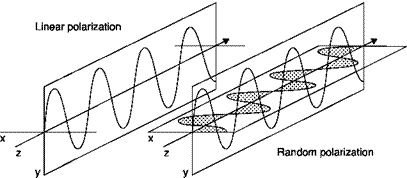Polarization
Lasers can be linearly or randomly polarized. The resonator of a laser creates standing waves of constant linear polarization. If special precautions are not taken, alternate longitudinal modes will have orthogonal polarization (Figure 4.6). Therefore, a laser is never really like a non-polarized thermal light source, it may be randomly polarized, i. e. it may issue a combination of orthogonally polarized radiation which, moreover, can vary over time. Introducing a Brewster angle window as a polarizing element within the laser cavity eliminates a state of polarization and produces a linearly polarized beam.
 |
However, random polarization can be a problem if the beam interacts with polarizing elements or reflective surfaces and is detected by photoelectric sensors. The temporal fluctuation of polarization, polarization noise, gives rise to fluctuations in intensity and causes noise in the optical detector. In these applications, the use of a linearly polarized laser is recommended.













